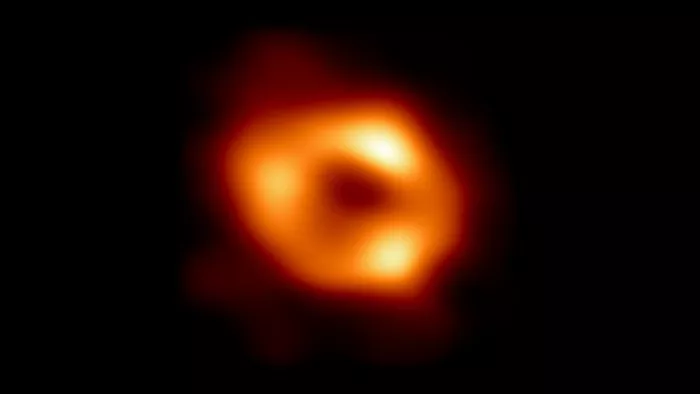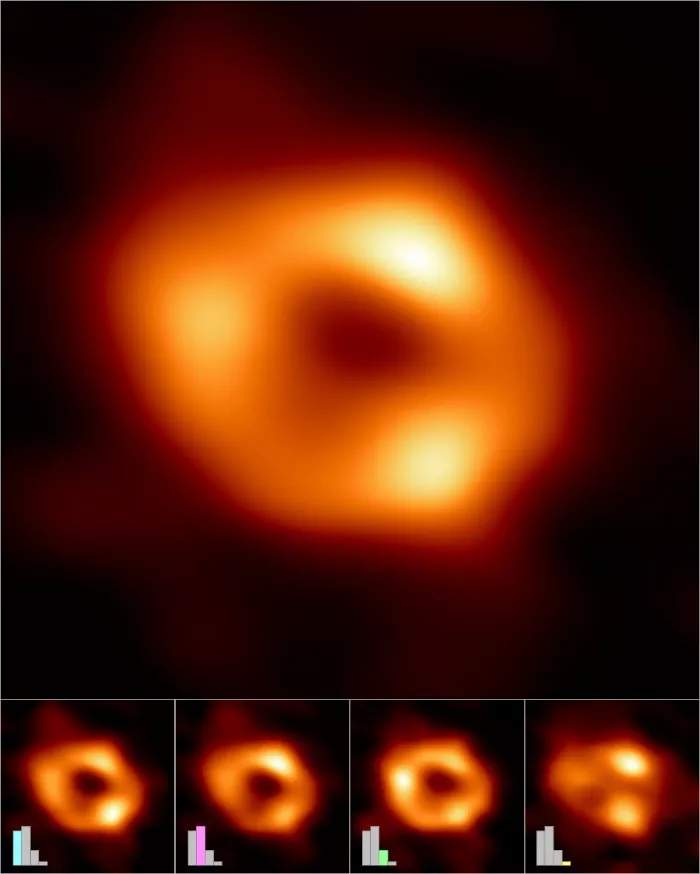At simultaneous press conferences around the world, including Shanghai, astronomers showed people the first picture of a supermassive black hole in the center of our Milky Way galaxy. This result gives an empirical evidence that the object is a black hole and provides valuable clues to understand the behavior of the "giant beast" believed to reside in the center of most galaxies. The photo was taken by the international research team organized by the event horizon telescope (EHT) through a network of radio telescopes distributed all over the world.

Figure 1: the first picture of a black hole in the center of the Milky Way Galaxy! (provided by eht cooperative organization)
This is the first photo of the supermassive black hole Sgr A in the center of our galaxy and the first direct visual evidence of the real existence of this black hole. The image was captured by an earth sized virtual telescope (EHT) consisting of eight radio telescopes distributed on the earth. The telescope is named after the event horizon (that is, the boundary of a black hole from which light cannot escape)*
Because the black hole does not emit light, we cannot see the black hole itself, but the rotating luminous gas gives a signal of its existence: a dark central region surrounded by a bright ring structure (called shadow). The light shown in the photo is caused by the strong gravitational bending of the black hole, which has a mass more than four million times that of the sun
This photo is an average of different photos extracted by the EHT team from the 2017 observation data of Sgr A (see Figure 2)*
This is a long-awaited true portrait of the massive object in the center of our Milky Way galaxy. Scientists have previously observed that many stars orbit an invisible, dense and massive object in the center of the Milky Way galaxy. This has strongly suggested that the object called Sagittarius A (SGR a ) is a black hole, and the photos released today provide the first direct visual evidence.
Because the black hole does not emit light, we cannot see the black hole itself, but the rotating luminous gas gives a signal of its existence: a dark central region surrounded by a bright ring structure (called shadow). The light shown in the photo is caused by the strong gravitational bending of the black hole, which has a mass more than four million times that of the sun.
"We are amazed that the size of the ring is surprisingly consistent with Einstein's prediction of general relativity," said Geoffrey bower, an eht project scientist from the Institute of astronomy and astrophysics. "These unprecedented observations have greatly improved our understanding of what is happening in the center of the Milky way and provided a new perspective for understanding how supermassive black holes interact with their surroundings.". The research results of the EHT team are published in the Astrophysical Journal communication in the form of a special issue today [see attached link for details ]
Because the black hole in the center of the Milky Way galaxy is 27000 light-years away from the earth, it looks about the same size as the doughnut on the moon 380000 kilometers away from the earth. In order to take this picture, the research team created the observation tool eht, a virtual telescope as big as the earth, which is composed of eight radio telescopes distributed in six places around the world [1 ]. Eht observed Sgr A * for several nights and collected data for several hours each time, just like the long-time exposure of the camera.
This is another major breakthrough after the EHT cooperation released the first black hole photo of mankind in 2019, capturing the central black hole (M87 *) in the more distant galaxy M87.
Although the black hole in the center of our Milky Way galaxy is more than 1500 times smaller and 1500 times lighter than M87 *, the two black holes look particularly similar [2 ]. "They come from two different types of galaxies and have very different black hole masses, but when we focus on the edges of these black holes, they look magically similar," said Professor sera Markoff, a theoretical astrophysicist from the University of Amsterdam and co chairman of the EHT Scientific Committee, "This tells us that objects close to the black hole are completely dominated by general relativity, and the different appearances we see in the distance are caused by the differences in the matter around the black hole.".
Although Sgr A is closer to us, this achievement is much more difficult than M87 . From steward Observatory Chi Kwan Chan, an eht scientist at the University of Arizona's Department of astronomy and Institute of data science, explained: "The gas around the black hole revolves around Sgr A and M87 at a high speed almost close to the speed of light. It takes a few days to several weeks for the gas to circle M87 in a week, but for a much smaller Sgr A the gas can circle in a few minutes. This means that the brightness and pattern of the gas around the supermassive black hole also change rapidly from time to time when eht observes Sgr A *. It is a bit like giving a small bird chasing its tail Take a clear picture of the dog.
Researchers had to develop new and complex tools to consider the gas movement around Sgr A . It is relatively easy to image M87 such a stable target with almost the same pattern, but it is completely different for Sgr A . The black hole photos of Sgr A are the average effect of different photos extracted by the research team. Finally, the "giant beast" hidden in the center of our Milky Way galaxy can be presented for the first time.
This was achieved by bringing together the wonderful ideas of the EHT cooperation organization composed of more than 300 researchers from 80 research institutions around the world. In addition to developing complex tools to overcome the challenges faced by Sgr A * imaging, the research team spent five years synthesizing and analyzing data with supercomputers, compiling an unprecedented black hole simulation database and strictly comparing the observation results.

Figure 2: the first picture of a black hole in the center of the Milky Way galaxy is made like this! (provided by eht cooperative organization)
The EHT team combined many photos extracted from the 2017 eht observation data of Sgr A to make a final photo of the supermassive black hole Sgr A in the center of the Milky Way galaxy
This final photo was generated by averaging thousands of images obtained using different calculation methods, all of which can accurately fit the EHT data. Finally, the photo retains the more common features in all different images and suppresses the uncommon features
The set of thousands of different images can be divided into four subsets according to their similar characteristics. The bottom row of the figure shows the average representative image of each subset. The images of the three subsets have a ring structure, but the brightness distribution around the ring is different. Although the images contained in the fourth subset can also match the data, they don't look like a ring
The histogram shows the relative number of images belonging to each subset. Each of the first three subsets has thousands of photos, while the fourth and smallest subset has only hundreds of photos. The height of the histogram represents the relative "weight" or contribution of each subset to the final picture
"Indeed, the data analysis of the first imaging observation of the black hole in the center of the Milky Way Galaxy took a lot of effort from the EHT team," said Lu Rusen, an eht partner from the Shanghai Observatory Jiang Wu, another eht partner from the Shanghai Observatory, added: "the research team traversed a huge imaging parameter space to determine this black hole photo."
Scientists are particularly excited to finally get pictures of two black holes of different sizes, which provides conditions for their comparative study. They have begun to use these new data to test theories and models of gas behavior around supermassive black holes. At present, this process is not completely clear, but it is considered to play a key role in the formation and evolution of galaxies.
"Now we can study the differences between these two supermassive black holes to obtain new clues that are valuable for understanding this important process," said Keiichi Asada, an eht scientist from the Institute of astronomy and astrophysics. "We have photos of two black holes with a mass difference of more than 1500 times. Compared with the past, we will be able to further test the gravity in extreme environments.".
Eht has not stopped the pace of observation and research: the joint observation with more telescopes was just completed in March this year. The continuous expansion and technological innovation of EHT will enable scientists to share more eye-catching photos, including black hole "movies" in the near future.
"Shooting such a 'movie' of the black hole in the center of the Milky Way galaxy is the pursuit of the next generation eht." Shen Zhiqiang, the domestic coordinator of EHT cooperation from Shanghai Observatory, said. "We are planning to build China's submillimeter wave VLBI telescope to participate in the 24-hour continuous relay observation of Sgr A *."
notes:
[1 ] the eight telescopes participating in eht observation in 2017 are Alma (akatama large millimeter submillimeter array), apex (Atacama Pathfinder experimental telescope), IRAM 30m telescope, jcmt (James Clark Maxwell Telescope), LMT (large millimeter wave telescope), SMA (submillimeter wave array), SMT (submillimeter wave telescope) and SPT (Antarctic telescope). Over the years, new telescopes have been added to eht, including GLT (Greenland telescope), noema (north sky extended millimeter wave array) and Kitt Peak 12m telescope.
[2 ] a black hole is the only celestial body known to us whose size is directly proportional to its mass. Two black holes with a size difference of 1000 times also have a mass difference of 1000 times.
More information:
Shanghai Observatory took the lead in organizing and coordinating domestic scholars to participate in the cooperation of the EHT project. This exciting achievement was strongly supported by the astronomy science center of the Chinese Academy of Sciences, the Chinese Academy of Sciences, the National Natural Science Foundation of China, the Ministry of science and technology, the China Postdoctoral Science foundation, the Shanghai "super postdoctoral" incentive plan, the Shanghai Branch of the Chinese Academy of Sciences, the German Max Planck Society and so on.
link
Eht website:< https://eventhorizontelescope.org/ >
Paper link: